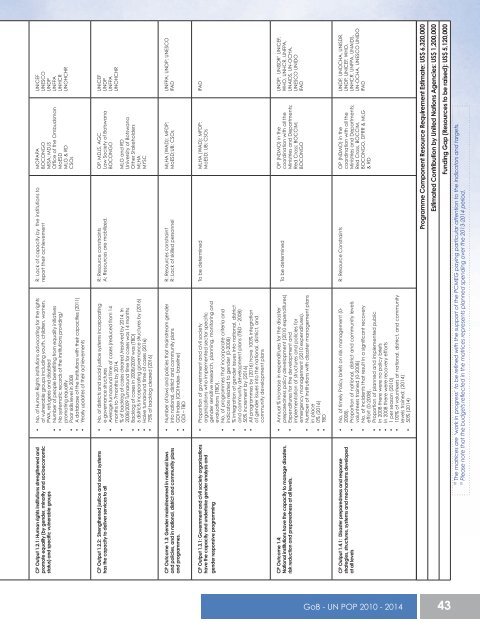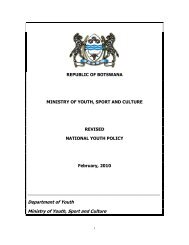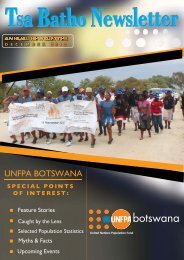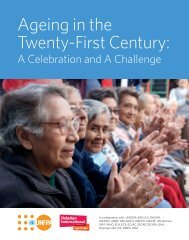GoB-UN POP 2010-2014 - UNFPA Botswana
GoB-UN POP 2010-2014 - UNFPA Botswana
GoB-UN POP 2010-2014 - UNFPA Botswana
- No tags were found...
You also want an ePaper? Increase the reach of your titles
YUMPU automatically turns print PDFs into web optimized ePapers that Google loves.
CP Output 1.2.1: Human rights institutions strengthened andpromote equality (by gender, minority and socioeconomicstatus) and specific vulnerable groups• No. of Human Rights institutions advocating for the rightsof vulnerable groups including youth, children, women,PWA, refugees and disabled• Number of people benefiting from equality initiatives• No systematic records of the institutions providing/promoting equality• Poor skills level in 2008• A database of the institutions with their capacities (2011)• Yearly updates of their achievementsR: Lack of capacity by the institutions toreport their achievementMOPAPABOCONGOMISA; MDJSOffice of the OmbudsmanMoESDMLG & RDCSOs<strong>UN</strong>ICEF<strong>UN</strong>ESCO<strong>UN</strong>DP<strong>UN</strong>FPA<strong>UN</strong>HCR<strong>UN</strong>OHCHRCP Output 1.2.2: Strengthened justice and social systemshas the capacity to deliver services to all• No. of districts and social justice systems incorporatinge-governance structures• Average turnaround time of cases (reduced from 14months to 7months by <strong>2014</strong>.• % of backlog of cases cleared /resolved by <strong>2014</strong>. In2008/2009 Turnaround time for cases was 14 months• Backlog of cases in 2008/2009 was (TBD)• 6 districts incorporating governance structures by (2016)• Halve turnaround time of cases (2016)• 75% of backlog cleared (2016)R: Resource constraintsA: Resources are mobilized.OP, MDJS, AGCLaw Society of <strong>Botswana</strong>BOCONGOMLG and RDUniversity of <strong>Botswana</strong>Other StakeholdersMLHAMYSC<strong>UN</strong>ICEF<strong>UN</strong>DP<strong>UN</strong>FPA<strong>UN</strong>OHCHRCP Outcome 1.3: Gender mainstreamed in national lawsand policies, and in national, district and community plansand programmes.• Number of laws and policies that mainstream genderinto national, district and community plans• GDI Index (GDI Index- baseline)• GDI – TBDR: Resources constraintR: Lack of skilled personnelMLHA (WAD); MFDP;MoESD;UB; CSOs<strong>UN</strong>FPA; <strong>UN</strong>DP; <strong>UN</strong>ESCOIFADCP Output 1.3.1: Government and civil society organizationshave the capacity and undertake gender analysis andgender responsive programming• Proportion of government and civil societyorganizations who implemented sector specificgender sensitive research, planning, monitoring andevaluations (TBD).• No. of programmes that incorporate criteria andindicators related to gender (0-2008)• % integration of gender issues into national, districtand community development plans (TBD – 2008)• 50% increment by (2016)• All programmes by (2016) have 100% integrationof gender issues into the national, district, andcommunity development plansTo be determined MLHA (WAD); MFDP;MoESD; UB; CSOsIFADCP Outcome 1.4:National institutions have the capacity to manage disasters,risk reduction and preparedness at all levels.• Annual % increase in expenditures for the disasterpreparedness policy development (<strong>2010</strong> expenditures)• Expenditures for the development andimplementation of structures and policies foremergency management (<strong>2010</strong> expenditures).• Number of institutions with disaster management plansin place• 0% (2016)• TBDTo be determinedOP (NDMO) in thecoordination with all theMinistries and Departments;Red Cross; BOCCIM;BOCONGO<strong>UN</strong>DP; <strong>UN</strong>ISDR’ <strong>UN</strong>ICEF,WHO, <strong>UN</strong>HCR, <strong>UN</strong>FPA,<strong>UN</strong>AIDS, <strong>UN</strong>-OCHA,<strong>UN</strong>ESCO <strong>UN</strong>IDOIFADCP Output 1.4.1: Disaster preparedness and responsestrategies, structures, systems and mechanisms developedat all levels• No. of timely Policy briefs on risk management (0-2008).• Proportion of national, district and community levelsvolunteers trained (0-2008)• No. of incidents that result in a significant recoveryeffort (0-2008).• Proportion of planned and implemented public• In 2008 there were no policy briefs• In 2008 there were recovery efforts• 1 per season (<strong>2010</strong>)• 100% of volunteers at national, district, and communitylevels trained; (<strong>2014</strong>)• 50% (<strong>2014</strong>)R: Resource Constraints OP (NDMO) in thecoordination with all theMinistries and Departments;Red Cross, BOCCIM,BOCONGO, DFRR & MLG& RD<strong>UN</strong>DP, <strong>UN</strong>OCHA, <strong>UN</strong>ISDR,<strong>UN</strong>DP, <strong>UN</strong>ICEF, WHO,<strong>UN</strong>HCR, <strong>UN</strong>FPA, <strong>UN</strong>AIDS,<strong>UN</strong>-OCHA, <strong>UN</strong>ESCO <strong>UN</strong>IDOIFADProgramme Component Resource Requirement Estimate: US$ 6,320,000Estimated Contribution by United Nations Agencies: US$ 1,200,000Funding Gap (Resources to be raised): US$ 5,120,00018The matrices are ‘work in progress’ to be refined with the support of the PCMEG paying particular attention to the indicators and targets.19Please note that the budgets reflected in the matrices represents planned spending over the 2013-<strong>2014</strong> period.<strong>GoB</strong> - <strong>UN</strong> <strong>POP</strong> <strong>2010</strong> - <strong>2014</strong> 43







